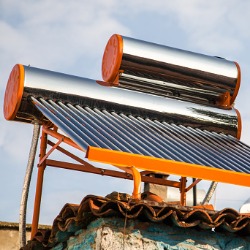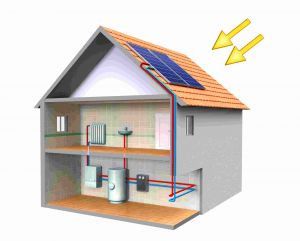More and more Australians are making an effort to reduce their energy bills, but many of us still struggle. We all know we could save power by switching off lights and installing energy-efficient appliances, but have you ever considered just how much energy your hot water system is using?
There are plenty of ‘efficient’ hot water systems on the market that promise bill savings, however, none are as cheap to run as solar hot water systems. So, what are solar hot water systems? What do they cost to purchase and run, and how much can you save? Canstar Blue answers these questions and more in this article.
On this page:
Advertisement
What is a solar hot water system?
Solar hot water systems utilise energy from the sun to heat water for your home. These systems can help to reduce at least 60% of household’s energy usage when compared to a conventional gas or electric systems, according to the Victorian Government’s sustainability website, and are thought to be particularly effective in warm climates. However, since you can’t always count on the sun to shine, most solar hot water systems also come with electric or gas boosters to ensure your home has enough hot water at all times of the day.
How does a solar hot water system work?
When it comes to solar hot water systems there are two different ways in which they work; either actively or passively. Active solar hot water systems use circulating pumps to keep the water heated as a it pumps through the system, whereas passive systems rely on heated pipes to keep the water heated as it moves through your home.
With an active system, it will either use the sunlight stored by the solar collector panel or a heat exchanger to heat the water as it’s moving through the system. Thanks to the circulating pump, an active system is able to keep the water heated during its motion, making it more reliable than an passive system, which has to store, collect and heat the water in the tank unit before moving. Since there is no pump in a passive system, these units are often coupled together, using thermosyphon technology to both collect the solar power and heat the water in the same place.
Passive systems are generally cheaper than an active system, but an active system is generally more dependable in cooler climates as passive systems are more susceptible to freezing. Active systems mostly come as a split unit – meaning the panel and water tank are two separate standing machines – whereas passive systems will generally be coupled. In Australia, the most common solar hot water system is an active system.
Active solar hot water systems also come with either an electric or gas booster to help power the system on cloudy days.
Types of solar hot water systems

There are three main types of solar hot water systems – flat-plate collectors, evacuated tube collectors and heat pump systems.
- Flat-plate collectors: This system uses a large solar panel–like collector to catch the sun’s rays and transfer the heat to an insulated hot water tank. Flat-plate collectors tend to be the more affordable solar hot water option however, they are not terribly effective in cooler climates. There are two variants of these systems – roof mounted – where the tank is connected to the collector on the roof, and split – where the panel is installed on the roof while the tank is on the ground.
- Evacuated tube collectors: These work similarly to flat-plate collector hot water systems. The difference is that this model collects sunlight using a series of glass tubes that have a vacuum seal. This allows for the efficient transferral of solar energy. As such, evacuated tube collector hot water systems are widely considered to be the most effective, however they are also the most expensive.
- Heat Pump systems: Unlike the other solar hot water systems which collect sunlight, heat pump solar systems draw solar heat from the air and use this to heat water. Heat pump solar systems do use some electricity to pump in hot air, but this is a fairly negligible amount.
Best solar hot water systems
Below is a list of some of the best hot water system brands as per the survey findings in our most recent hot water systems rating report. Our annual surveys only ask customers who have bought a hot water system recently. These are some of the current brands from that list who offer solar hot water systems in Australia:
Learn more about these rated brands, from price to products and services, in Canstar Blue’s annual hot water systems customer satisfaction ratings.
Solar hot water system price Australia
According to pricing estimates from Solar Quotes, a solar hot water system costs anywhere between $3,000 and upwards of $6,000 fully installed. Prices vary depending on the type of system and installation costs:
- Flat plate collectors: Prices typically sit between $3,000 and $4,000.
- Evacuated tub collectors: Prices are usually upwards of $6,000.
- Heat pumps: These are comparatively affordable, costing about $3,000.
In addition, solar hot water systems with gas boosters can cost around $500 to $1,000 more compared with their electric-booster counterparts. Further, split systems are more expensive than roof-mounted hot water storage tanks.
Some households may also be eligible for a rebate or concession on the installation of their solar hot water system, which can also impact the overall price. To see if you make the cut, visit your state or territory government’s website for more information.
Got a rooftop solar system installed too? Make sure you aren’t missing out on a better solar feed-in tariff with these solar-specific electricity deals
Here are some of the cheapest solar-specific deals from the retailers on our database. These costs are based on the Ausgrid network in Sydney but prices will vary depending on your circumstances. We show one product per retailer, listed in order of lowest price first. Annual price estimates assume general energy usage of 3900kWh/year for a residential customer on a single rate tariff. Price estimates exclude solar feed-in tariff credits. These are products from referral partners†. Our database may not cover all deals in your area, and please check retailer websites for up to date information.
Here are some of the cheapest solar-specific deals from the retailers on our database. These costs are based on the Citipower network in Melbourne but prices will vary depending on your circumstances. We show one product per retailer, listed in order of lowest price first. Annual price estimates assume general energy usage of 4000kWh/year for a residential customer on a single rate tariff. Price estimates exclude solar feed-in tariff credits. These are products from referral partners†. Our database may not cover all deals in your area, and please check retailer websites for up to date information.
Here are some of the cheapest solar-specific deals from the retailers on our database. These costs are based on the Energex network in Brisbane but prices will vary depending on your circumstances. We show one product per retailer, listed in order of lowest price first. Annual price estimates assume general energy usage of 4600kWh/year for a residential customer on a single rate tariff. Price estimates exclude solar feed-in tariff credits. These are products from referral partners†. Our database may not cover all deals in your area, and please check retailer websites for up to date information.
Here are some of the cheapest solar-specific deals from the retailers on our database. These costs are based on SA Power network in Adelaide but prices will vary depending on your circumstances. We show one product per retailer, listed in order of lowest price first. Annual price estimates assume general energy usage of 4000kWh/year for a residential customer on a single rate tariff. Price estimates exclude solar feed-in tariff credits. These are products from referral partners†. Our database may not cover all deals in your area, and please check retailer websites for up to date information.
What are the advantages of getting a solar hot water system?

As solar hot water systems rely on energy from the sun, some of the advantages include being less reliant on the electricity grid, reducing your carbon footprint and greenhouse gas emissions, and of course, saving money in the long-term on your electricity bill. Solar hot water systems also require less maintenance and servicing than a regular hot water system, with servicing generally only needed once every five years. It’s best to read the safety certificates before purchasing your system though for an accurate servicing schedule.
Additionally, Small-scale Technology Certificates (STC’s) are also available for solar and heat pump installations across all states in Australia. These are similar to solar feed-in tariffs, in that customers who install solar pumps are eligible to receive financial incentives for their use of clean and renewable energy.
Different STC’s are applicable to the different climate zones in Australia. Climate zones and an STC calculator can be found on the Australian Government’s Clean Energy Regulator website.
Will my solar hot water system cost less than other systems?
While solar hot water systems are expensive to purchase, they are typically much cheaper to run than gas or electric storage hot water systems. The exact amount it costs to run a hot water system varies wildly depending on your location, climate and energy tariff. With that said, an average household with a solar hot water system and moderate weather should save at least a 60% on their water heating bill compared to a storage hot water system, according to the Victorian Government’s sustainability website.
The Victorian Government’s website also states that depending on the type of solar hot water system in use, annual energy usage can differ from $55 to $110 annually, whereas other hot water systems will see costs of as much as $615 annually, depending on fuel type.
Is solar hot water right for me?
If you live in a warm and dry area, then installing solar hot water should be a no-brainer – while solar is more expensive upfront, the energy savings should see you make your money back in no time. However, the decision to install solar hot water is a little trickier for those in some of the colder areas in Australia’s southern states.
Most households in cooler climates should still be able to make their money back over the long-term with a solar hot water system, but if you’re on the fence about it, then you should get a personalised quote to ensure that you’re making the best choice for your budget.
Image credit: Andrea Danti/Shutterstock.com




Share this article